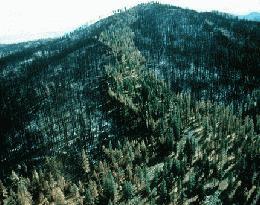On July 24, 1994, lightning ignites a forest fire in the Wenatchee National Forest at Tyee Creek that will burn for 33 days before it is contained. The fire destroys 35 homes and cabins, but many more structures are saved by the efforts of firefighters and by the fire prevention strategies of homeowners. Other fires in the region on Hatchery Creek and Rat Creek consume another 40,000 acres. The Tyee Creek fire is one of the largest forest fires in Washington in the twentieth century.
Lightning storms on July 24 started a number of fires along Tyee Creek, about 20 miles north of Wenatchee. The area had originally been covered with ponderosa pine, which has a thick bark and is resistant to fire. Periodic fire was essential to the tree's life cycle and also burned off smaller trees and brush. The pine was harvested and Douglas fir, less resistant to fire, grew in its place. The aggressive fire suppression policies of the U.S. Forest Service, the State of Washington, and private timberland owners since the early 1900s resulted in a buildup of brush on the forest floor. Home construction in wilderness areas placed structures at risk during fires unless the homeowners cleared vegetation from around buildings.
More than 2,775 firefighters worked on the fire lines and approximately 1,000 Marines from Camp Pendleton, California, were added to the effort.
The deaths of 34 firefighters across the nation that year and the fires around Wenatchee provided another opportunity for proponents of new forestry practices to question the U.S. Forest Service's tradition of aggressive fire suppression. In 1995, the U.S. Government agencies responsible for wildfire policies -- the Forest Service, the National Park Service, the Bureau of Land Management, and the Fish and Wildlife Service -- developed the National Fire Plan. Under this program, local land managers developed fire management plans that included prescribed burning (planned, controlled burning of brush and other buildup of fuel), removing vegetation, and small- and large-scale suppression.
Timber on state-owned and privately owned lands blackened by the Tyee Creek Fire was salvaged to recover the economic benefit and to remove potential fuel for other fires. The Forest Service offered timber from its lands for sale, but that process took so long that much of the wood had lost its value and buyers could not afford to comply with the environmental guidelines on logging operations.

